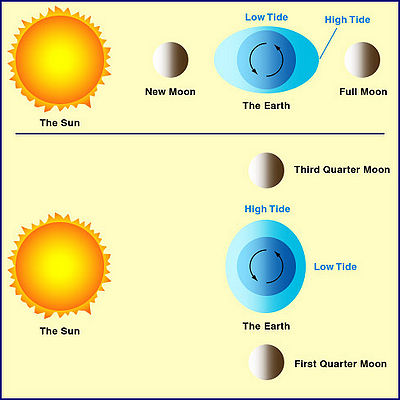(→See also: red links) |
|||
| (12 intermediate revisions by 11 users not shown) | |||
| Line 1: | Line 1: | ||
| − | '''Tides''' | + | [[Image:Tides.jpg|right|400px]] |
| + | '''Tides''' are the rise and fall of water levels in larger bodies of water. Every day, there are two "high tides," when the water levels rise, and two "low tides," when water levels fall. | ||
| − | == | + | Tides are one of the most reliable phenomena in the world.<ref>http://oceanservice.noaa.gov/education/kits/tides/tides01_intro.html</ref> Tides on the [[Earth]] result from the [[Moon]]'s gravity, which is just enough stronger on the near side of the earth to attract ocean water more than on the far side. Fishermen, sailors and other observers have long noted that the twice-daily cycle of high tides and low tides corresponds to the Earth's rotation under the moon. |
| − | + | ||
| − | + | When the moon is collinear with the sun and the Earth, then tides are stronger; when it forms an angle with the Earth and the sun, tides are weaker. | |
| + | |||
| + | ==References== | ||
| + | {{reflist}} | ||
| + | |||
| + | |||
| + | [[Category:Earth Sciences]] | ||
Latest revision as of 16:57, July 26, 2016
Tides are the rise and fall of water levels in larger bodies of water. Every day, there are two "high tides," when the water levels rise, and two "low tides," when water levels fall.
Tides are one of the most reliable phenomena in the world.[1] Tides on the Earth result from the Moon's gravity, which is just enough stronger on the near side of the earth to attract ocean water more than on the far side. Fishermen, sailors and other observers have long noted that the twice-daily cycle of high tides and low tides corresponds to the Earth's rotation under the moon.
When the moon is collinear with the sun and the Earth, then tides are stronger; when it forms an angle with the Earth and the sun, tides are weaker.
